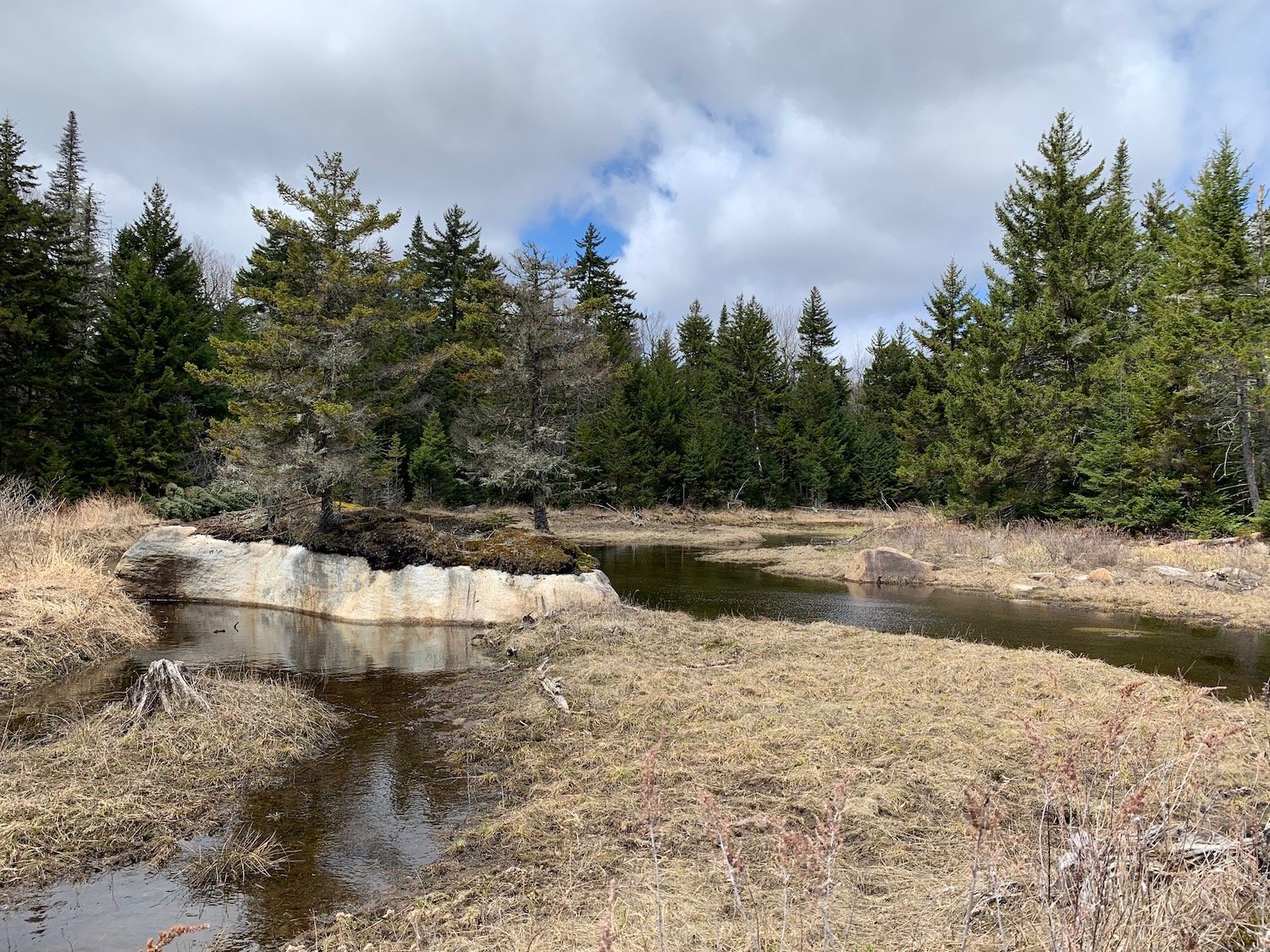A Hike to Bog Meadow
Bog Meadow in mid-April.
There's no trailhead for the Bog Meadow Trail. No kiosk. No register the DEC asks you to sign in the event a search party is needed to go in for a rescue. The only evidence of human activity is the faint winding corridor you follow through a mix of pines and hardwoods to the remarkable wetland that's aptly named "Bog Meadow."
This is the heart of what Paul Schaefer called Cabin Country.
"Into this country in 1921 came our family of seven -- straight from the streets of Schenectady in the Capital District. There was Father, who had climbed the Alps, and Mother, who despite her precarious health, was always the life of the family. I was a youngster of 13, with two brothers and sisters."
So he writes in Adirondack Cabin Country, his classic memoir of the wilderness published three years before his death in 1996.
While the land gives no indication of where the Bog Meadow Trail begins, our National Geographic map shows it starting about where Sugar Hill Road meets Edwards Hill Road. Paul wrote:
The intersection of Sugar Hill Road with Edwards Hill Road. You’ll want to park here.
"Edward's Hill Road climbs two miles into the highlands from Route 8. When I turn off the highway, I enter Cabin Country. The drive along the road brings back years of memories, not just of the mountains, forests, rivers, and lakes but of the wonderful people who live there. Many of them are descendants of the original settlers who forged worthy lives from the beauty and harshness of the mountains. Many others, like myself, come for renewal. Some come and stay, others come when possible."
To get to Bog Meadow, turn off Route 8 onto Edwards Hill Road and drive about a mile along the northern slope of Eleventh Mountain looming on the left. Look for the sign that says "Sugar Hill Road."
Park on Edwards Hill Road and hike up Sugar Hill. About a half-mile in, you'll pass the remains of the "Old Log Cabin" that Paul bought with his brother Vincent in 1926, thanks to a "combination of family encouragement and the saving of a few dollars from our apprentice courses."
This photo of the Old Log Cabin was taken from what we today call Sugar Hill Road, along which the Bog Meadow Trail runs until the road ends and becomes a lightly maintained path. Vincent was 20 at the time, and Paul just 18.
"It was a simple structure of adz-hewn logs, eight or twelve inches in diameter. Though its logs were weathered by nearly a century of storms and its roof layered patch upon patch, it became our pride and joy at once. It had but two rooms, one with a table, chairs, and a wood stove, and the other with bunks. As we were able, we added a fireplace, and then a well with a sweep, rope and pail to lift the cold, nectar-like water from its depths."
Vincent was 20 at the time, and Paul just 18. Possession of this cabin, Paul wrote, "quickly changed my life."
"My friends from the city now had a place with free lodging in a vast wild region where they could hunt deer and bear and fish for trout. And I had, without cost, free transportation almost whenever I wanted it, in rather ancient open touring cars in which we nearly froze when it got cold."
He continued:
"As we began to use the cabin, the whole country began to challenge us. We found streams and lakes abundant with trout and trails with fresh tracks of deer and bear. The nearby mountains were trail-less and exceeded three-thousand feet in height. We soon were standing on storm-swept peaks looking out to distant horizons. On one mountain, we discovered five streams, one of which was fed by a great swamp and spawned a cataract a thousand feet high..."
That was Eleventh Mountain, which Paul decided to rename Cataract Mountain because he found it more descriptive.
This chimney is all that remains of Paul and Vincent Schaefer’s Old Log Cabin.
Seven years after acquiring the Old Log Cabin, Paul in 1933 obtained from a forest ranger his first state permit to establish a hunting camp at an "ancient beaver meadow" three miles into the woods "at the end of a boulder-strewn trail." When you hike the Bog Meadow Trail, you're following about two miles of the same route over which Paul and fellow members of his "Cataract Hunting Club" used a horse and wagon to bring in supplies.
The racket made by the wagon wheels rolling and bumping over boulders in the track notified every deer and bear within two miles of their impending doom," notes Jim Schaefer, Paul's nephew. "At least they heard it leaving after delivery, which likely led to a good hunt after all."
Paul described the camp as "two 14- by 16-foot wall tents" joined at the "east end of an acre of grass and sunshine." He wrote:
"This part of the wilderness is wild and precipitous. Mechanized vehicles have been left far behind. Ancient hardwoods dominate the forest. Spruce and balsam line the waters and are etched against the skyline on mountaintops. From our tents, sunsets, often of crimson and burnished gold, light the narrow valley between the mountains to the west. Some nights, the stars hang like lanterns in a black velvet sky. And on others, moonlight drenches the land and sparkles on running streams."
When you come to the end of Sugar Hill Road, you'll veer right and enter the wilderness. This three-minute video will show you the way.




